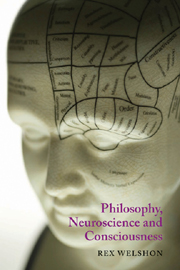Book contents
- Frontmatter
- Contents
- Preface
- Introduction
- PART I PHILOSOPHY AND CONSCIOUSNESS
- PART II NEUROSCIENCE AND CONSCIOUSNESS
- 5 Cortical evolution and modularity
- 6 Arousal, perception and affect
- 7 Attention, working memory, language and executive function
- 8 Neural models of conscious properties
- PART III PHILOSOPHY, NEUROSCIENCE AND CONSCIOUSNESS
- Concluding semi-scientific postscript
- Appendix Functional neuroanatomy
- Notes
- Bibliography
- Index
5 - Cortical evolution and modularity
from PART II - NEUROSCIENCE AND CONSCIOUSNESS
- Frontmatter
- Contents
- Preface
- Introduction
- PART I PHILOSOPHY AND CONSCIOUSNESS
- PART II NEUROSCIENCE AND CONSCIOUSNESS
- 5 Cortical evolution and modularity
- 6 Arousal, perception and affect
- 7 Attention, working memory, language and executive function
- 8 Neural models of conscious properties
- PART III PHILOSOPHY, NEUROSCIENCE AND CONSCIOUSNESS
- Concluding semi-scientific postscript
- Appendix Functional neuroanatomy
- Notes
- Bibliography
- Index
Summary
Neuroscience is the scientific study of the brain and nervous system. It is a large field and immediately splits into four subfields. Neuroanatomy is the scientific study of the form and structure of the brain and nervous system. Neurophysiology is the scientific study of the physical and biochemical processes of the brain and nervous system. Neuropsychology is the scientific study of the relationships between, on the one hand, the brain and nervous system and, on the other, perceptual, interoceptive, proprioceptive, affective and cognitive processes and functions. Neuropsychiatry is the scientific study of neuropsychological dysfunctions. Given these distinctions, we can put the relations between the subfields like this: neurophysiology studies the physical and biochemical processes that neuroanatomically identified things enter into, neuropsychology studies the psychological functions of neurophysiologically identified processes, and neuropsychiatry studies dysfunctions of neuropsycho-logically identified processes.
Evidence from neuroanatomy, neurophysiology, neuropsychology and neuro-psychiatry that there are neural correlates of conscious properties is rapidly accumulating. In this and the next three chapters, select evidence for these correlates is presented. Most of it comes from neuroanatomical and neuro-physiological fMRI and PET imaging studies of neural function, from comparative neurophysiology and neuropsychology, and from neuropsychiatric studies of neuropsychological dysfunction in humans. An entrée into this empirical work can be made by reviewing the evolutionary history of human brains. This chapter focuses on cortical evolution, the structural modularity of the brain, and the controversial claim that consciousness is an evolutionary module.
- Type
- Chapter
- Information
- Philosophy, Neuroscience and Consciousness , pp. 100 - 123Publisher: Acumen PublishingPrint publication year: 2010



